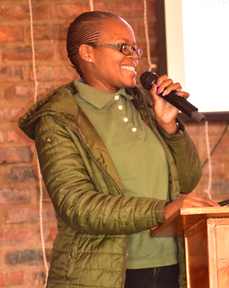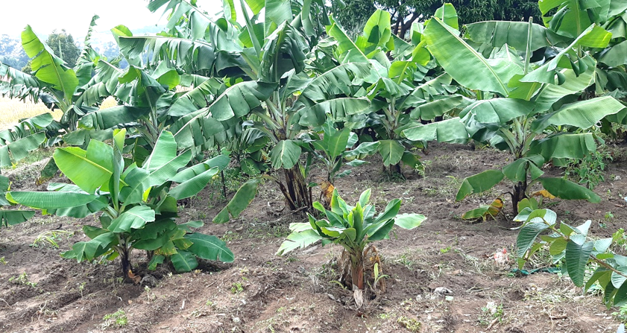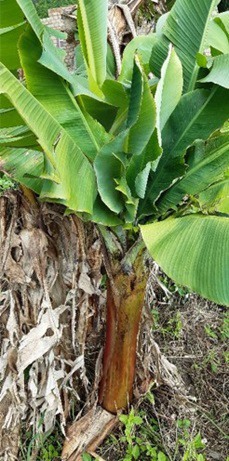 Despite rumours that banana bunchy top virus has been found in South Africa's Mpumalanga Province, where much of the country's bananas are grown, the virus has not been positively identified outside KwaZulu-Natal Province, confirms Dr Sinethemba Ximba, researcher at the Agricultural Research Council in Mbombela (right).
Despite rumours that banana bunchy top virus has been found in South Africa's Mpumalanga Province, where much of the country's bananas are grown, the virus has not been positively identified outside KwaZulu-Natal Province, confirms Dr Sinethemba Ximba, researcher at the Agricultural Research Council in Mbombela (right).
In collaboration with the Department of Agriculture, Land Reform and Rural Development, Dr Ximba and colleagues are conducting regular surveys among rural households and commercial farms to determine and monitor the spread of banana bunchy top virus (BBTV).
Samples from a banana farm on the KwaZulu-Natal South Coast tested positive for banana bunchy top virus in 2015; that farm can no longer grow bananas. The presence of the virus has since also been confirmed in a rural household on the KZN North Coast.
Dr Ximba remarks that the disease has hit the food security of rural households in this area hard; she and her team have been begged by villagers to spare their diseased plants from destruction but, she says, they have to consider the welfare of the entire banana industry.
In Mozambique, where a substantial amount of South Africa's bananas are grown, banana bunchy top virus was confirmed present in 2007. The fact that it has not spread across the border from southern Mozambique to northeastern South Africa, is good news for the industry, she says, as the losses from the disease BBTV can be very crippling.
Banana bunchy top virus is highly contagious. "If your neighbour has it, you have reason to be worried that you might be the next to have it as it spreads via aphids and infected planting material," she adds. Symptoms of infected plants includes a characteristically upright growth habit (hence the name "bunchy top"), malformed bunches, dot-dash symptoms on the midribs reminiscent of Morse code. So-called "J-hooks" can be seen on the underside of the leaves when held against the light.
The characteristically upright growth habit (hence the name "bunchy top") of a BBTV-infected plant (photo: Dr Tendekai Mahlanza)
Early detection of infected aphids through a sticky trap is one strategy employed to aid in field detection, amongst others that are being developed at the ARC, she says. A project on banana bunchy top virus, funded by the Department of Agriculture, Land Reform and Rural Development, was implemented at a commercial banana farm in Komatipoort, Mpumalanga Province in July 2024. Surveys together with awareness and training on symptom identification are on-going throughout banana-producing regions.
"When we conducted surveys previously across banana-producing regions between 2016-2021 we would use bucket traps filled with water and Sunlight liquid. The downside to this, was that the traps needed to be serviced after 24 hours whereas with the sticky traps, they can be left for three to four weeks in the field. This is, therefore, an improved technique specifically for this project."
Aphid control  They've been learning from their Zambian counterparts, who advocate constant scouting and the destruction of diseased plants showing symptoms (which occurs roughly within three months of infection). Dr Ximba emphasizes that it is important to first kill the aphids on the diseased plant (right), and then to spray the plant with a herbicide like glyphosate.
They've been learning from their Zambian counterparts, who advocate constant scouting and the destruction of diseased plants showing symptoms (which occurs roughly within three months of infection). Dr Ximba emphasizes that it is important to first kill the aphids on the diseased plant (right), and then to spray the plant with a herbicide like glyphosate.
For the purpose of controlling aphids, the ARC advises imidacloprid, a controversial insecticide which will not be around for much longer, technical advisors point out.
The list of registered chemicals on bananas are fewer than the fingers on one hand, notes Dr Johan van der Waals of RealIPM, removing the option of alternating chemicals. He points out that imidacloprid is only registered for bananas as a stem injection, not as a drench, and registered for use with glyphosate to kill the infected plant. Additionally, the withholding period is 180 days for harvest of fruit, very difficult with a fruit harvested almost continuously like bananas.
"The one thing to understand is that many of the insecticides we use for aphids are particularly harsh on their natural enemies like hoverflies," he continues. "You have all kinds of beetles and flies and lacewings that would come to your assistance in a functioning ecosystem. By choosing your chemicals correctly and by applying the right biologicals, you can get to this."
BBTV manipulates banana cells' own DNA replication At the ARC's Roodeplaat quarantine facility outside Pretoria, banana plants have been inoculated with the virus to identify which plant genes show increased expression due to infection, and what overwhelmingly comes up, observes Dr Tendekai Mahlanza (right), are the genes involved in banana DNA replication.
At the ARC's Roodeplaat quarantine facility outside Pretoria, banana plants have been inoculated with the virus to identify which plant genes show increased expression due to infection, and what overwhelmingly comes up, observes Dr Tendekai Mahlanza (right), are the genes involved in banana DNA replication.
The ARC researchers' purpose is to develop bananas that are resistant to banana bunchy top virus, and because of the challenges of conventional banana breeding, Dr Mahlanza says, gene editing provides the most viable alternative for the genetic improvement of the banana. The aim, after identifying which banana genes are interacting with the six genomic components of the banana bunchy top virus – an unusually high number of components introducing a high level of complexity – would be to render those banana genes unavailable to the virus to carry out its work.
It is a model that has been used successfully on many other pathogens and plants, but many in the local banana industry feel that South African regulation is currently stifling the benefits that could be derived from gene editing: the country is one of three in the world that considers all products of gene editing as genetically modified organisms (GMOs), a decision upheld last year by the former agriculture minister despite appeals from organised agriculture, and it makes it difficult for South African farmers to access gene-edited products.. For more information:
For more information:
Dr Sinethemba Ximba
Agricultural Research Council – Tropical and Subtropical Crops
Tel: +27 13 753 7000
Email: infoitsc@arc.agric.za
https://www.arc.agric.za/arc-itsc/Pages/ARC-ITSC-Homepage.aspx
Sign up for our daily Newsletter and stay up to date with all the latest news!
Subscribe I am already a subscriber